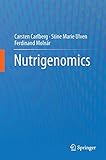Nutrigenomics / Carsten Carlberg, Stine Marie Ulven, Ferdinand Molnár
Por: Carlberg, Carsten [autor].
Ulven, Stine Marie [autora] | Molnár, Ferdinand [autor].
Tipo de material: Libro
impreso(a)
Editor: New York, New York, United States: Springer International Publishing, 2016Descripción: xxi, 222 páginas : fotografías, ilustraciones, mapas, retratos ; 24 centímetros.ISBN: 3319304135; 9783319304137.Tema(s): Nutrigenómica
Libro
impreso(a)
Editor: New York, New York, United States: Springer International Publishing, 2016Descripción: xxi, 222 páginas : fotografías, ilustraciones, mapas, retratos ; 24 centímetros.ISBN: 3319304135; 9783319304137.Tema(s): Nutrigenómica| Tipo de ítem | Biblioteca actual | Colección | Signatura | Estado | Fecha de vencimiento | Código de barras |
|---|---|---|---|---|---|---|
| Libros |
Biblioteca San Cristóbal
Texto en la configuración de la biblioteca San Cristóbal |
Acervo General | 612.3 C3 | Prestado | 25/02/2021 | ECO010019790 |
Incluye bibliografía
Part I. Introduction.. 1. Nutrition and Common Diseases.. 1.1 Human nutrition.. 1.2 Nutrition and obesity.. 1.3 Nutrition and cáncer.. 1.4 Nutrition and diabetes.. 1.5 Nutrition and cardiovascular diseases.. 1.6 Impact of exercise. 2. Human Genomic Variation.. 2.1 Migration and evolutionary challenges of the modern human.. 2.2 Diversity of human populations.. 2.3 Genetic variants of the human genome.. 2.4 The HapMap Project and haplotype blocks.. 2.5 Genome-wide association studies.. 2.6 Whole genome sequencing and the 1000 Genomes Project.. Part II. Molecular Genetic Basis.. 3. Sensing Nutrition.. 3.1 Nutrient-sensing mechanisms.. 3.2 Nutrient-sensing via nuclear receptors.. 3.3 Functions and actions of PPARs.. 3.4 Integration of lipid metabolism by LXRs and FXR.. 3.5 Coordination of the immune response by VDR.. 3.6 Circadian control of metabolic processes.. 4. Nutrigenomics: Adapting the Human Genome to Dietary Changes and Personalized Nutrition.. 4.1 Definition of nutrigenomics.. 4.2 Vitamin D and skin color.. 4.3 Human genetic adaption to dietary changes.. 4.4 Regulatory SNPs and quantitative traits.. 4.5 "Omics" analysis in nutrition sciences.. 4.6 Integrative personal omics profile.. 5. Nutritional Epigenomics.. 5.1 Epigenetic mechanisms.. 5.2 Intermediary metabolism and epigenetic signaling.. 5.3 One-carbon metabolism and DNA methylation.. 5.4 Nutrition-triggered transgenerational epigenetics in mice.. 5.5 Epigenetic programming in humans.. 6. Nutritional Signaling and Aging.. 6.1 Aging and conserved nutrient-sensing pathways.. 6.2 Neuroendocrine aging regulation in humans and other mammals.. 6.3 Caloric restriction from yeast to mammals.. 6.4 Properties and functions of sirtuins.. 6.5 Cellular energy status sensing by AMPK
7. Chronic Inflammation and Metabolic Stress.. 7.1 Central role of monocytes and macrophages.. 7.2 Acute and chronic inflammation.. 7.3 Reverse cholesterol transport and inflammation.. 7.4 M1 and M2 macrophages in adipose tissue.. 7.5 ER stress response.. Part III. Links to Diseases.. 8. Obesity.. 8.1 Definition of obesity.. 8.2 Adipogenesis.. 8.3 Energy homeostasis.. 8.4 Hormonal regulation of food anticipation.. 8.5 Adipose tissue as an endocrine organ.. 8.6 Inflammation in adipose tissue.. 8.7 Genetics of obesity.. 9. Glucose Homeostasis, Insulin Resistance and Β Cell Failure.. 9.1 Glucose homeostasis in health.. 9.2 Principles of insulin signaling.. 9.3 Central role of FOXO transcription factors.. 9.4 Insulin resistance in skeletal muscle and liver.. 9.5 β cell failure.. 10. Diabetes.. 10.1 Definition of diabetes.. 10.2 Failure of glucose homeostasis in T2D and its treatment.. 10.3 Genetics of T2D.. 10.4 Thrifty gene hypothesis.. 11. Hypertension, Atherosclerosis and Dyslipidemias.. 11.1 Hypertension.. 11.2 Mechanisms of aterosclerosis.. 11.3 Cholesterol metabolism and lipoproteins.. 11.4 Dyslipidemias.. 12. Metabolic Syndrome.. 12.1 Definitions of the metabolic syndrome.. 12.2 Whole body's perspective on the metabolic syndrome.. 12.3 Metabolic syndrome in key metabolic organs.. 12.4. Genetic and epigenetic basis of the metabolic syndrome.. Additional Reading
The fascinating area of Nutrigenomics describes this daily communication between diet, food and nutrients, their metabolites and our genome. This book describes how nutrition shapes human evolution and demonstrates its consequences for our susceptibility to diseases, such as diabetes and atherosclerosis. Inappropriate diet can yield stress for our cells, tissues and organs and then it is often associated with low-grade chronic inflammation. Overnutrition paired with physical inactivity leads to overweight and obesity and results in increased burden for a body that originally was adapted for a life in the savannas of East Africa. Therefore, this textbook does not discuss a theoretical topic in science, but it talks about real life, and our life-long "chat" with diet. We are all food consumers, thus each of us is concerned by the topic of this book and should be aware of its mechanisms. The purpose of this book is to provide an overview on the principles of nutrigenomics and their relation to health or disease. We are not aiming to compete with more comprehensive textbooks on molecular nutrition, evolutionary biology, genomics, gene regulation or metabolic diseases, but rather will focus on the essentials and will combine, in a compact form, elements from different disciplines. In order to facilitate the latter, we favor a high figure-to-text ratio following the rule "a picture tells more than thousand words". eng
The content of this book is based on the lecture course "Nutrigenomics", which is held since 2003 once per year by Prof. Carlberg at the University of Eastern Finland in Kuopio. The book is subdivided into three sections and twelve chapters. Following the "Introduction" there are sections on the "Molecular genetic basis" and the "Links to disease", which take a view on nutrigenomics from the perspective of molecular mechanisms or from the causes of metabolic diseases, respectively. Besides its value as a textbook, Nutrigenomics will be a usefull reference for individuals working in biomedicine. eng
